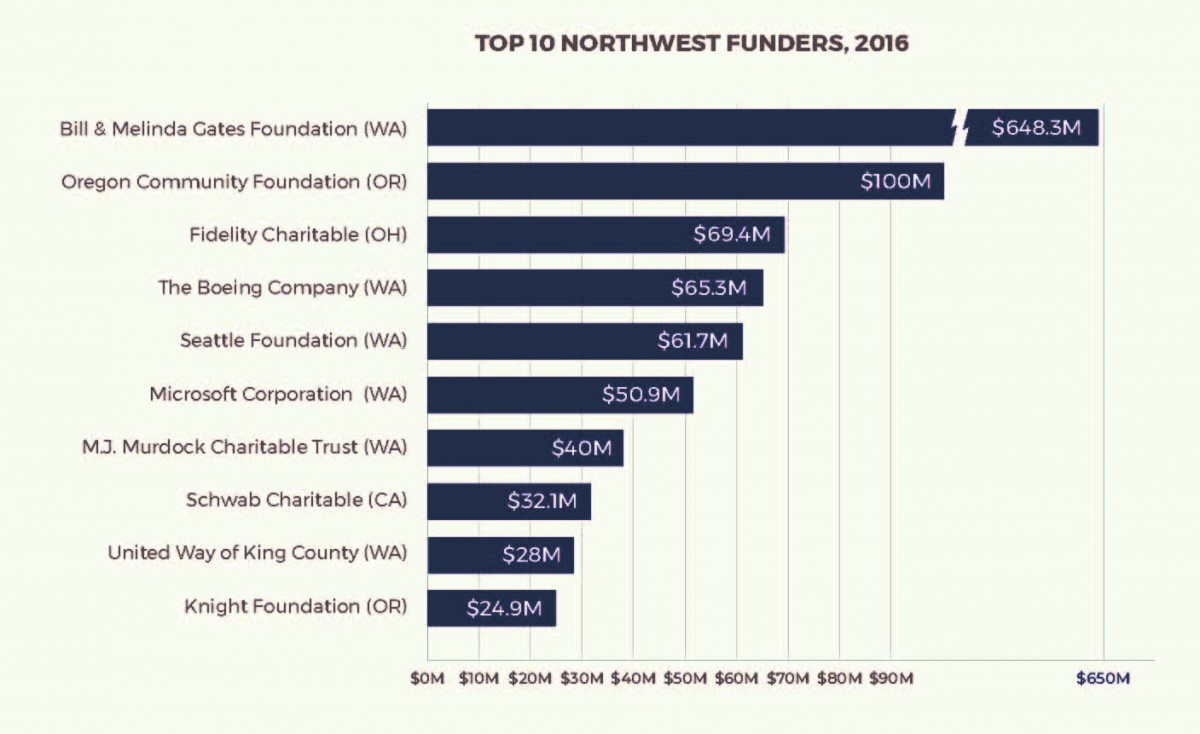 Trends in Northwest Giving began as a project of Philanthropy Northwest in 2006 and has been published every two years as an aggregation and analysis of grantmaking trends that shape our region — Alaska, Idaho, Montana, Oregon, Washington and Wyoming. Much of our sector’s growth, as well as the deep roots that strengthen our communities, is reflected throughout each report. The Trends in Northwest Giving 2019 report focuses on the most recent data available, through fiscal year 2016, and includes a combination of information from our membership network, Form 990s and intermediaries.(1)
Trends in Northwest Giving began as a project of Philanthropy Northwest in 2006 and has been published every two years as an aggregation and analysis of grantmaking trends that shape our region — Alaska, Idaho, Montana, Oregon, Washington and Wyoming. Much of our sector’s growth, as well as the deep roots that strengthen our communities, is reflected throughout each report. The Trends in Northwest Giving 2019 report focuses on the most recent data available, through fiscal year 2016, and includes a combination of information from our membership network, Form 990s and intermediaries.(1)
We recognize that these data have many limitations. A few to note include a time lag in the collection of the data and publication; reliance on self-reported information by thousands of different organizations all with their own systems of classifying giving; the burden of reporting that creates an imbalance in reporting especially by smaller organizations; a focus on giving trends that necessitates emphasis on large grants over small; and a focus on recent trends versus long term trends. Despite these limitations, this report still provides an important high-level representation of broad trends in philanthropic giving in our six-state region.
Data alone doesn’t capture the human impact of philanthropy. That’s why this year, we’ve added regional spotlights to help capture the changemakers behind the grants. I hope these stories will inspire funders across the nation to collaborate with and invest in vibrant, diverse communities in our region and beyond. More than ever, our democracy needs those with power and resources to make brave decisions, to share their experiences with one another and to work together for the common good.
Highlights From Trends in Northwest Giving
- Overall giving in our region grew substantially. Grantmaking to the Northwest increased by 19% from 2014 to 2016 among the same funders.
- Education and health remain major priorities. As in our last report and in keeping with current national trends, the largest portion of grant dollars awarded in the Northwest funded education (31%) and health (29%) efforts.
- Family foundations are leading the way. Forty-two percent of our region’s funding in 2016 came from family foundations. Of the $1.3 billion contributed by family foundations in the Northwest, the Bill & Melinda Gates Foundation awarded $648 million.
- The Northwest benefits significantly from national corporate funders. Eight percent of our region’s grantmaking came from corporate funders, with Boeing and Microsoft once again leading the way as Fortune 100 corporations in our region.
- Small grants can make a huge impact. Similar to our earlier reports, the median size of Northwest grants in 2016 was $5,000, and 95% of the region’s grants were less than $100,000.
- Native organizations receive more funds in the Northwest than nationally. While a majority of grants across the nation support populations facing economic hardships, only a narrow slice of these grant dollars slated for specific groups is allocated specifically for people of color. In 2016, a higher percentage of grant dollars classified for specific population groups were allocated for American Indian communities (1.5%) in the Northwest compared to the 0.8% nationally.(2) (Again, this information is based on self-reported data from thousands of philanthropic(3) organizations, all of which may classify their giving to populations using different criteria.) Despite this regional increase in funding to Native communities, overall giving to Indigenous populations is still inequitable compared to giving to other population groups.
- Program development receives the largest share of funding. Mirroring national trends, U.S. foundations and corporate funders awarded the greatest portion of grant dollars in 2016 to program development, including technical assistance, place-based programs and capacity building.
State by State Summaries and Spotlights
You can read all the state summaries and spotlights, including about grants made to American Indian and Alaska Native populations in this report excerpt. Or you can view the excerpts individually by state. Just click the links below.

The future of philanthropy in the Northwest is bright. By understanding where we’ve come from; acknowledging and addressing inequity in our giving and our communities, and learning and doing through regional collaboration, we can make even more positive changes in the communities that are counting on us.
Special thanks to Foundation Center, which joined forces with GuideStar in early 2019 to create the nonprofit Candid. Candid collected and analyzed this vast pool of data so that we can put it to use in the Northwest. We appreciate all the organizations that reported their grants to help shape an understanding of giving in our region.
We at Philanthropy Northwest invite you to connect with us and share your views from the field about important giving trends you’re seeing firsthand. Download the full report and let us know your thoughts by reaching out to our team by email. We hope this report sparks conversations about funding patterns in the region, especially the trends that you notice developing locally or by funding priorities.
Endnotes
1 For details about the data used or the collection and analysis procedures, please see the Methodology section in the full Trends report.
2 See Figure: Distribution of Grants to Recipients in the Northwest Region vs. National by Population Served, 2016, page 10 of the full Trends report.
3 For detailed information about how Candid classified population data once they received it from grantmakers or to learn more about how any of the data were classified, visit their website at taxonomy.candid.org.